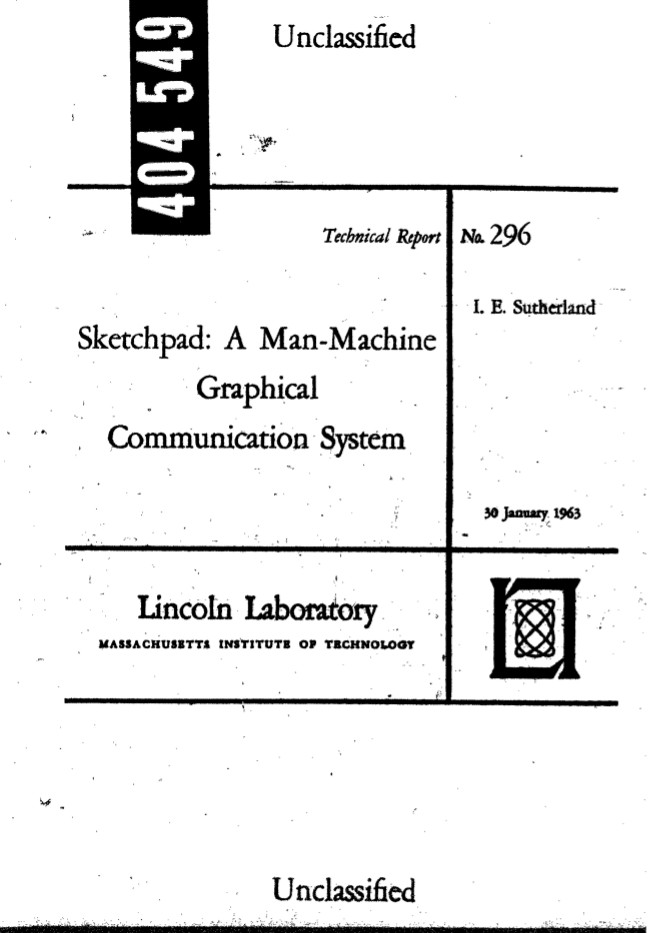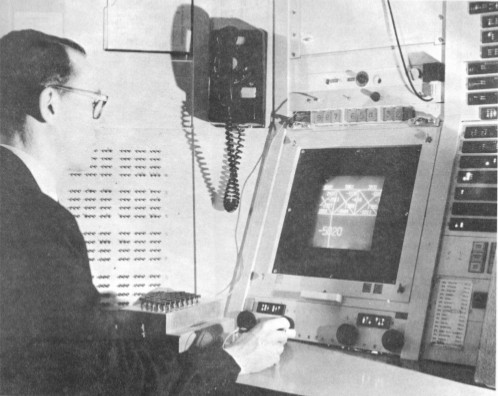Ivan Edward Sutherland: Sketchpad: A Man-Machine Graphical Communication System (1963/2003)
Filed under thesis | Tags: · computing, design, drawing, interface, software, technology


This technical report is based on a dissertation submitted January 1963 by the author for the degree of Doctor of Philosophy to the Massachusetts Institute of Technology.
“The Sketchpad system uses drawing as a novel communication medium for a computer. The system contains input, output, and computation programs which enable it to interpret information drawn directly on a computer display. It has been used to draw electrical, mechanical, scientific, mathematical, and animated drawings; it is a general purpose system. Sketchpad has shown the most usefulness as an aid to the understanding of processes, such as the notion of linkages, which can be described with pictures. Sketchpad also makes it easy to draw highly repetitive or highly accurate drawings and to change drawings previously drawn with it. The many drawings in this thesis were all made with Sketchpad.
A Sketchpad user sketches directly on a computer display with a ‘light pen.’ The light pen is used both to position parts of the drawing on the display and to point to them to change them. A set of push buttons controls the changes to be made such as ‘erase,’ or ‘move.’ Except for legends, no written language is used.
Information sketched can include straight line segments and circle arcs. Arbitrary symbols may be defined from any collection of line segments, circle arcs, and previously defined symbols. A user may define and use as many symbols as he wishes. Any change in the definition of a symbol is at once seen wherever that symbol appears.
Sketchpad stores explicit information about the topology of a drawing. If the user moves one vertex of a polygon, both adjacent sides will be moved. If the user moves a symbol, all lines attached to that symbol will automatically move to stay attached to it. The topological connections of the drawing are automatically indicated by the user as he sketches. Since Sketchpad is able to accept topological information from a human being in a picture language perfectly natural to the human, it can be used as an input program for computation programs which require topological data, e.g., circuit simulators.
Sketchpad itself is able to move parts of the drawing around to meet new conditions which the user may apply to them. The user indicates conditions with the light pen and push buttons. For example, to make two lines parallel, he successively points to the lines with the light pen and presses a button. The conditions themselves are displayed on the drawing so that they may be erased or changed with the light pen language. Any combination of conditions can be defined as a composite condition and applied in one step.
It is easy to add entirely new types of conditions to Sketchpad’s vocabulary. Since the conditions can involve anything computable, Sketchpad can be used for a very wide range of problems. For example, Sketchpad has been used to find the distribution of forces in the members of truss bridges drawn with it.
Sketchpad drawings are stored in the computer in a specially designed ‘ring’ structure. The ring structure features rapid processing of topological information with no searching at all. The basic operations used in Sketchpad for manipulating the ring structure are described.” (from the Abstract)
PhD thesis
Originally submitted at the Massachussets Institute of Technology, January 1963
Technical report published by University of Cambridge, September 2003
New preface by Alan Blackwell and Kerry Rodden
ISSN 1476-2986
149 pages
Sketchpad presentation with comments by Alan Kay (video)
PDF (original thesis, 1963)
PDF (2003 edition)
Cornelia Vismann: Files: Law and Media Technology (2000/2008)
Filed under book | Tags: · bureaucracy, computing, document, governmentality, law, media archeology, media theory, technology, writing

“Quod non est in actis, non est in mundo. (What is not on file is not in the world.) Once files are reduced to the status of stylized icons on computer screens, the reign of paper files appears to be over. With the epoch of files coming to an end, we are free to examine its fundamental influence on Western institutions. From a media-theoretical point of view, subject, state, and law reveal themselves to be effects of specific record-keeping and filing practices. Files are not simply administrative tools; they mediate and process legal systems. The genealogy of the law described in Vismann’s Files ranges from the work of the Roman magistrates to the concern over one’s own file, as expressed in the context of the files kept by the East German State Security. The book concludes with a look at the computer architecture in which all the stacks, files, and registers that had already created order in medieval and early modern administrations make their reappearance.”
Originally published in German as Akten. Medientechnik und Recht, Fischer, Frankfurt am Main, 2000
Translated by Geoffrey Winthrop-Young
Publisher Stanford University Press, 2008
Meridian: Crossing Aesthetics series
ISBN 080475151X, 9780804751513
187 pages
Review (Liam Cole Young, Theory, Culture & Society)
PDF (7 MB, updated on 2016-12-23)
Comment (0)Yolande Harris: Scorescapes: On Sound, Environment and Sonic Consciousness (2011)
Filed under thesis | Tags: · consciousness, environment, listening, sound, sound art, technology
“Scorescapes investigates how sound mediates our relationship to the environment, and how contemporary multidisciplinary art practices can articulate this relationship. It joins my own artistic practice with a theoretical analysis of the field, highlighting how relationships to the environment drawn through sound are profoundly bound up with technology. Key concepts include: making the inaudible audible; underwater sound and cetacean communication; field recordings and the contextual basis of sound; typologies of listening; the score as relationship; and techno-intuition.
Scorescapes negotiates a role for the artist and composer as a researcher, creating hybrid methods and developing alternative forms of knowledge that heighten personal awareness through direct engagement with sonic environments. Working closely with composers David Dunn, Alvin Lucier and Pauline Oliveros, and with bio-acoustic scientist Michel André, I tested and applied theoretical ideas, generating unexpected artistic research questions and methods. These included the need to distinguish between audification, sonification and visualization processes, the paucity of research on underwater sonic environments and the anthropocentric bias towards environmental sound.” (from the Abstract)
PhD thesis
Academy for Creative and Performing Arts, Faculty of Humanities, Leiden University
Supervisors: Frans de Ruiter, David Dunn, Bob Gilmore
146 pages
via leidenuniv.nl

